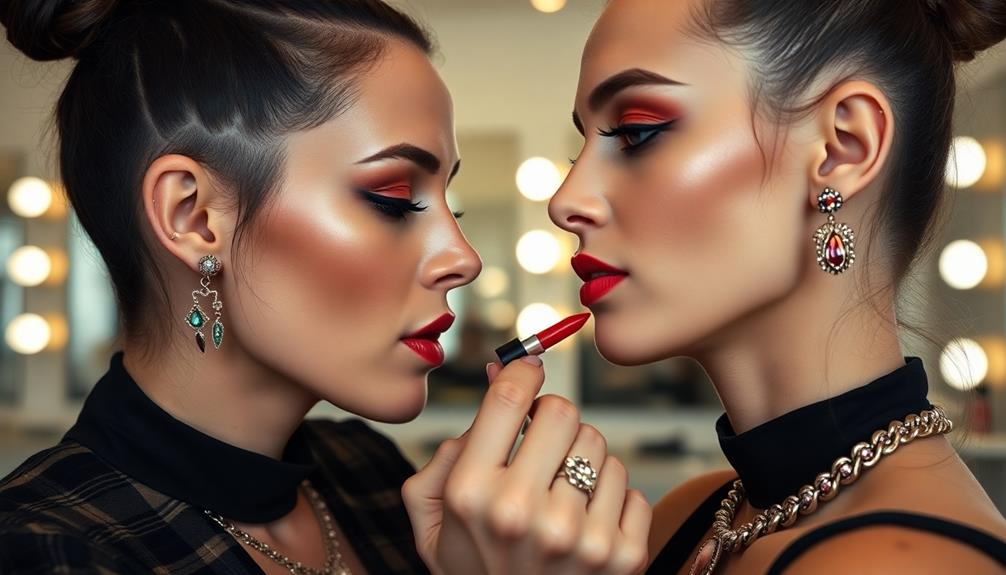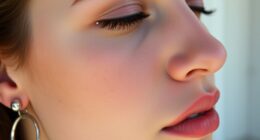Teachers with piercings often face strict school policies that limit personal expression. Many schools, like those in Wilson County, prohibit visible piercings to maintain a professional environment. This can lead to disciplinary actions for non-compliance. While some educators argue that piercings are personal identity markers, others worry about safety and distraction in the classroom. The debate continues around balancing individual expression with school decorum. As societal norms shift towards acceptance, ongoing discussions highlight the need for school policies to evolve. If you want to find out how these dynamics play out in different environments, keep exploring the topic further.
Key Takeaways
- Teachers in Wilson County Schools are subject to the same piercing policies as students, affecting their ability to express personal style.
- Inconsistencies in the enforcement of piercing policies can lead to varied experiences for teachers and students regarding self-expression.
- Visible piercings among teachers may challenge traditional notions of professionalism and promote discussions around individual identity.
- Embracing teachers' piercings could foster a more inclusive environment, reflecting the evolving acceptance of diverse appearances in society.
- Clear communication about school policies is essential for teachers to navigate personal expression while adhering to institutional standards.
Overview of School Policies

School policies regarding piercings can considerably impact both teachers and students. In Wilson County Schools, visible piercings on the nose, tongue, lips, cheeks, or eyebrows are strictly prohibited. This strict enforcement means that non-compliance can lead to suspensions, creating a tense environment where personal expression is limited. These policies aim to maintain discipline and a professional atmosphere within the school.
Teachers often have varied responses to student piercings. While some strictly enforce the rules, others show leniency, which can create inconsistencies in how policies are applied. This mixed response highlights the ongoing debate among board members about the potential distractions piercings may cause.
Recent discussions surrounding policy changes emphasize the need to find a balance between self-expression and adherence to school rules. It's vital to reflect on how these policies affect student mental health and their overall educational experience.
The Debate on Disruption

The ongoing discussion about school policies on piercings naturally leads to the question of disruption in the classroom. Some argue that visible piercings can create an environment of inequality among students.
Board member Wiley Boyette points out that non-pierced students might feel disadvantaged in a setting where teachers flaunt body modifications.
Additionally, Christine Fitch raises concerns about how piercings could alter speech patterns, potentially disrupting classroom dynamics.
In contrast, many students find piercings commonplace and not distracting, suggesting shifting societal norms around body modifications.
The debate around disruption also highlights inconsistencies in policy enforcement among teachers. This inconsistency can lead to varied experiences for students, as some educators embrace a more lenient approach while others stick to strict adherence to school rules.
Key points include:
- Visible piercings may create feelings of inequality among students.
- Concerns exist about potential impacts on speech and classroom dynamics.
- Students' perceptions of piercings vary, with many seeing them as non-disruptive.
Ultimately, the issue of disruption remains a complex topic in the conversation surrounding piercings in educational settings.
Significance of Self-Expression

For many students, piercings serve as an essential form of self-expression that considerably shapes their personal identity and boosts their confidence. You might find that having a pierced nose or ears allows you to showcase your individuality, helping you stand out in a crowd.
Janna Elawar highlights how piercings can create common ground among peers, fostering a sense of belonging within your community. As society evolves, these body modifications have become more commonplace and accepted, challenging traditional notions of professionalism in schools.
Without your piercings, you may feel a sense of loss, almost as if you're "naked." This emotional connection to your bodily adornments illustrates how deeply intertwined personal identity and self-expression can be.
As schools debate policies on piercings, it's imperative to recognize these feelings. You and your peers argue for the importance of individual expression, emphasizing that self-identity shouldn't be stifled by institutional rules.
In this scenario, being pierced becomes more than just a trend; it's a fundamental aspect of who you are. Embracing this significance can lead to a more inclusive environment where everyone feels valued for their uniqueness.
Navigating Dress Code Compliance

Steering through the complexities of dress code compliance can be a challenge, especially when piercings are an important part of your self-expression. Many schools enforce strict dress codes that may not align with your personal style, particularly regarding visible facial piercings.
Understanding how to navigate these policies is vital for maintaining your individuality while adhering to school regulations.
Here are a few strategies to help you comply with dress code requirements:
- Use clear retainers: They allow you to keep your piercings while blending in with school expectations.
- Know your school's policies: Familiarize yourself with the specific dress code rules to better understand what's acceptable.
- Communicate with administration: If you're unsure about a particular policy, don't hesitate to ask questions or seek clarification.
Staying compliant with the dress code is essential, as non-compliance can lead to disciplinary actions like isolation or extra supervision.
Balancing your need for personal expression with adherence to school standards can be tough, but it's possible to find a middle ground that respects both facets of your identity.
Health and Safety Considerations

When it comes to teachers with piercings, health and safety can't be ignored.
You should consider the risks during physical activities, as piercings can lead to injuries.
Additionally, proper aftercare is vital to prevent infections and complications, making education on body modifications essential.
Health Risks Overview
Numerous health risks are associated with body piercings, particularly for teachers who may engage in physical activities or handle emergencies in school settings. Understanding these risks is crucial to guarantee a safe environment for both educators and students.
Consider the following health risks:
- Infections and Allergic Reactions: Improper aftercare can lead to infections or allergic reactions, resulting in abscesses or systemic issues.
- Physical Hazards: During sports or physical activities, piercings can pose safety hazards, increasing the risk of injury if jewelry gets caught or pulled.
- Bloodborne Pathogens: Schools often worry about the transmission of bloodborne pathogens, especially in scenarios where first aid might be required.
The American Academy of Pediatrics highlights the importance of proper hygiene and aftercare for piercings to mitigate these health risks.
Certain piercings, particularly oral ones, can lead to dental problems like chipped teeth or gum damage.
As a teacher, it's crucial to be aware of these implications to maintain not just your health, but also the safety and well-being of your students.
Safety During Activities
Safety in school activities is paramount, especially when it comes to managing the risks associated with body piercings.
School boards have noted that piercings could lead to injuries during physical activities or sports. If not properly managed, these risks can greatly impact your safety and well-being.
Health concerns also arise from infections related to piercings, especially if proper hygiene and aftercare aren't followed.
It's crucial to recognize that while self-expression is important, it shouldn't come at the cost of safety during activities.
Visibility of piercings in physical education classes can create distractions, potentially affecting your focus and performance.
Schools work to maintain a safe environment, but challenges arise when enforcing safety protocols. Non-compliance with aftercare can complicate the situation further, making it harder to guarantee everyone's safety.
To address these issues, schools must find a balance between allowing personal expression and implementing effective safety measures.
Clear guidelines should be made available to help you understand how to manage piercings during activities, making sure that both your safety and your ability to express yourself are respected.
Aftercare Procedures Importance
Understanding aftercare procedures is important for maintaining healthy piercings and minimizing risks associated with them. Proper aftercare can prevent infections and complications like abscesses or allergic reactions, which can be especially concerning for one student with facial piercings.
Here are some key aftercare guidelines to follow:
- Clean the piercing regularly with saline solution.
- Avoid touching or twisting the jewelry during the healing process.
- Consult with professional piercers for personalized aftercare advice.
Students need to be aware of the health implications of body piercings, particularly the risks during physical activities where jewelry can get caught or cause injuries.
The school board emphasizes that educating students on safe aftercare practices is important for reducing health risks. By taking these precautions, you not only promote healing but also guarantee that your piercing doesn't lead to unnecessary complications.
Cultural Perspectives on Piercings

As you look around, you might notice how piercings have shifted from being seen as rebellious to a common form of self-expression.
For many, these adornments serve as important identity markers that enhance confidence and individuality.
This cultural evolution raises questions about how schools should navigate the balance between personal expression and institutional policies.
Evolving Norms in Society
In recent years, the acceptance of piercings among youth has surged, reflecting a significant cultural shift towards embracing personal expression. Many students view piercings—like having their nose pierced—as crucial components of their identity. This evolution in societal norms means students often feel "naked" without their piercings, underscoring their importance.
This shift parallels the way individuals seek methods to promote emotional well-being, often turning to techniques like aromatherapy for anxiety relief, highlighting the desire for comfort and self-expression in various forms.
However, school policies frequently clash with these changing attitudes. Educators and board members worry that piercings may distract from learning, while students argue that other forms of self-expression, like tattoos, are often perceived as more distracting.
This ongoing debate highlights critical points of contention:
- The clash between institutional rules and personal expression.
- The growing acceptance of diverse appearances in mainstream culture.
- A shift towards prioritizing individuality over strict conformity.
As society increasingly values these expressions, schools must navigate a complex landscape. Finding a balance between maintaining decorum and allowing personal expression will be essential.
Embracing this change can lead to an inclusive environment where students feel comfortable showcasing their identities, reinforcing the notion that piercings are more than just adornments; they're a fundamental part of who you are.
Piercings as Identity Markers
The growing acceptance of piercings reflects deeper cultural meanings, particularly for youth who use them as identity markers. When you see a classmate with their lip pierced, it often signals more than just a fashion choice; it represents their personal style, cultural affiliations, and a powerful form of self-expression.
As digital creativity becomes increasingly important in shaping identities, many students leverage their piercings to express not only their individuality but also their innovative spirit, which is linked to the importance of digital creativity. As societal norms shift, many students feel that their piercings contribute greatly to their identity and confidence.
Janna Elawar emphasizes that piercings create common ground among peers, fostering a sense of belonging and shared identity in school environments. For you and your friends, these adornments can feel like essential parts of who you are. In fact, many students report feeling "naked" without their piercings after wearing them for extended periods, highlighting how personally important these choices can become.
However, the prevalence of piercings among youth also raises questions about balancing individual expression with institutional policies. Schools often regulate such expressions, creating a tension between personal identity and the rules of the institution.
As you navigate this landscape, understanding the cultural significance of your piercings can help you advocate for your right to express yourself authentically.
Frequently Asked Questions
Can Teachers Wear Piercings?
Yes, teachers can wear piercings, but it usually depends on the school's policies. You should check your district's guidelines, as some may allow visible piercings while others may enforce strict grooming standards.
Why Should Piercings Be Allowed in School?
Piercings should be allowed in school because they promote individuality and self-expression. Allowing them fosters a positive environment, boosts confidence, and can enhance students' overall educational experience without causing significant distractions in the learning atmosphere.
Are Teachers Allowed to Have Tattoos?
Did you know 36% of teachers have tattoos? Whether you're allowed to have visible tattoos often depends on your school's specific dress code policies, which can vary widely based on the community's standards and values.
Can English Teachers in Japan Have Piercings?
In Japan, you might find policies on piercings vary. At public schools, strict rules often apply, while private language schools may allow more freedom. Ultimately, it depends on the school's culture and expectations.
Conclusion
In a world where teachers wear their identities like vibrant paint on a canvas, the clash of school policies and personal expression can feel like a stormy sea. Steering through these waters requires balance; understanding the need for professionalism while embracing individuality. As you ponder the role of piercings in education, remember that each adornment tells a story, a thread in the rich tapestry of culture and self-expression that shapes our learning environments. Let's celebrate this diversity, not stifle it.
Hi, my name is Danielle, and I’m an author for piercings-body.com. I have a passion for writing and love to share my knowledge on all things body piercing-related. I’m also a huge advocate for safe body modification practices and believe everyone should be able to make informed decisions about their bodies. When I’m not writing or blogging, I enjoy spending time with my family and friends, practicing yoga, and exploring new places.

















